Anyone who works with storing and protecting large volumes of data has probably already heard of RAID.
Redundant Array of Independent Disks, as RAID can be translated, is a technique used to improve the performance and reliability of data storage. It is especially important in situations where data security is essential.
In this article, you’ll learn all about RAID, what it does and how to apply this technique.
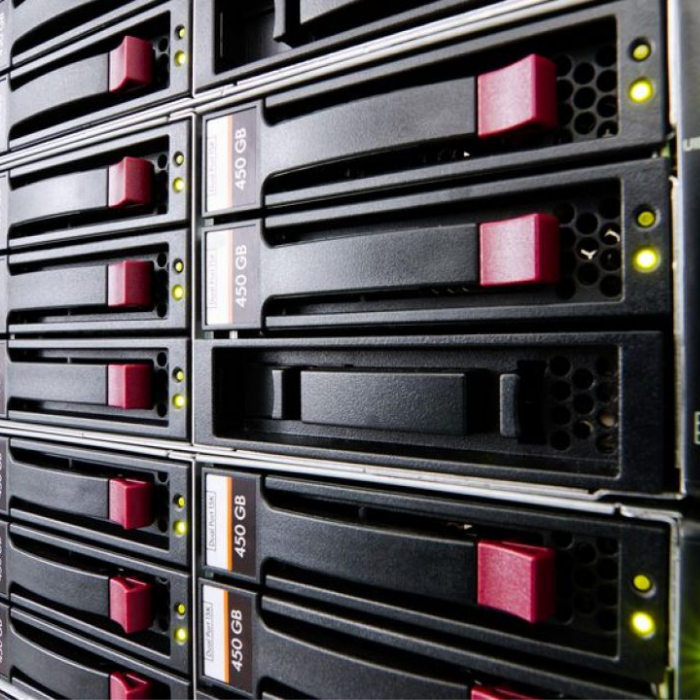
What is RAID?
RAID is a storage technique that uses a set of disk or SSD drives to increase processing speed and/or data protection. RAID stands for Redundant Array of Independent Drives, which can be translated as Redundant Array of Independent Disks.
The technique consists of creating a storage subsystem with several individual disks, as if they were “building blocks”. This way, the computer interprets all the available drives as one storage unit: if you have 2 disks of 2TB,2 TB, the operating system understands it as just 1 disk of 4 TB. There are different RAID models for doing this, as we’ll see later.
This technique was presented in 1988 by three researchers from the University of California at Berkeley, in an article called “A Case for Redundant Arrays of Inexpensive Disks (RAID)”. The term was later changed from “inexpensive disks” to “independent disks”, to get away from the idea of “cheap disks”.
What is the function of RAID?
The function of RAID is to create redundancy as well as performance. Redundancy means that the data is stored in more than one place among all the disks that make up the array, so that if one of the disks fails, the data is safe on the other disks. This way, the system can continue to function normally.
For RAID to offer greater security and/or better performance for data storage, it depends on the type used. Let’s take a closer look:
Increased security
The RAID redundancy system provides greater security. Even if one of the disks fails, the others ensure that the data is not lost, because they store the same files.
But it’s important to know that RAID is no substitute for backup, which is the best way to guarantee recoverability. This system cannot resist simultaneous disk failures, such as power problems, virus infections or operational errors. So the data is still susceptible to total loss.
Better performance
RAID can also increase data read and write speeds by dividing the tasks across several disks, but this depends on the system used, as we will see below.
The improvement in storage performance is also evident in the system’s solutions to mechanical problems with disks. When disks or SSDs fail, RAID allows the system to recover quickly and continue working.
What are the types of RAID?
Let’s start to understand in more detail how RAID works and the different types that exist: distribution, mirroring and parity. Understand now:
Distribution RAID
Distribution RAID divides data recording across different disks. In this method, the files are not repeated on the different disks, so that they are not overloaded with excess information and process the data more quickly.
Therefore, the focus of distribution RAID is on the speed of reading and writing data, which makes the computer faster. However, it loses out on security and reliability, since data loss on one disk or SSD also makes the data on the other disks inaccessible.
So you see, distribution RAID has no redundancy. For this reason, some people don’t consider it a type of RAID.
Mirroring RAID
In mirroring RAID, as the name suggests, the data is mirrored on the various disks in the system. In other words, identical copies of the original files are stored on at least one other disk in the system.
Its main purpose is to ensure data redundancy, which guarantees greater file security. On the other hand, speed is not improved, since the recording process is replicated on several disks. In addition, the cost of implementation tends to be higher, since a large part of the disks is dedicated to copies of the files.
Parity RAID
Parity RAID creates additional data stored next to the original files. This guarantees the security of the system because, in the event of a disk or SSD failure, this data allows the files to be reconstructed without any loss of information.
Parity is different from mirroring, which makes a complete copy of the files on different disks. In this way, parity RAID optimizes system security and performance at the same time, as it allows complete data recovery without taking up space with file copies.
What are the RAID levels?
In the article from the University of California, which introduced the use of the term RAID, the authors have already presented the different levels of RAID that can exist. They represent the types of disk arrangements and the technology they use to gain redundancy and/or performance.
Currently, there are more levels, variations and combinations, but we will now present the main ones:
RAID 0
In RAID 0, also called striping, the content is divided between all the hard disks so that they read and write the data simultaneously.
Yherefore, it is e a type of distribution RAID, which compromises security by not having copies on the other disks, but strengthens performance. For this reason, many people don’t consider RAID 0 to be a type of RAID.
RAID 0 is usually used in applications that deal with large volumes of data and must have fast processing speeds, such as image processing and video editing.
Advantages
- Increases processing speed;
- Reduces the cost of memory expansion;
- It is an easy technique to implement.
Disadvantages
- Compromises data security;
No mirroring or data parity.
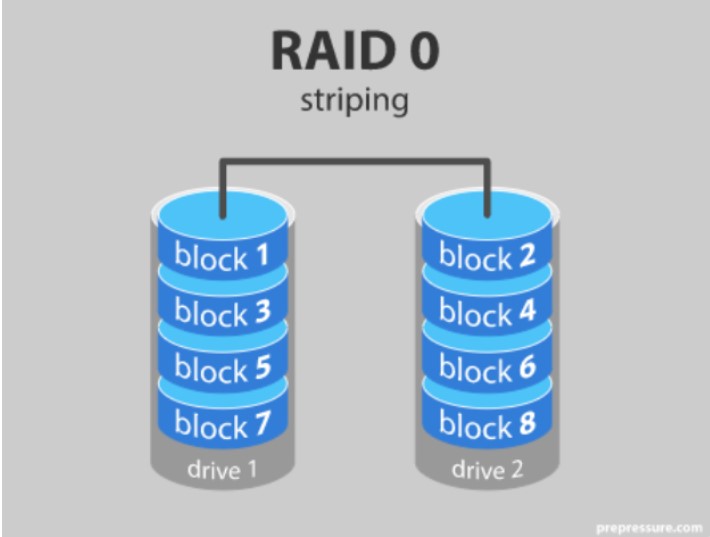
Fonte: Dicas de Infra
RAID 1
RAID 1 provides security for physical failures in storage drives. At this level, data is copied to one or more disks in the system. Every time there is a change in the data, it is modified on all the disks.
Therefore, uses the mirroring type of RAID, which focuses on data security to the detriment of speed, since processing has to be carried out on each disk.
RAID 1 is one of the most widely used, especially in units that cannot suffer data loss or downtime. Its function is to ensure that the machine is available even in the event of failures.
Advantages
- Provides data security, with identical copies on the other disks;
Guarantees machine availability in the event of a failure.
Disadvantages
- The effective storage capacity is only half of the drive’s total capacity;
- Increases the cost of memory expansion;
- Can affect processing speed.o.
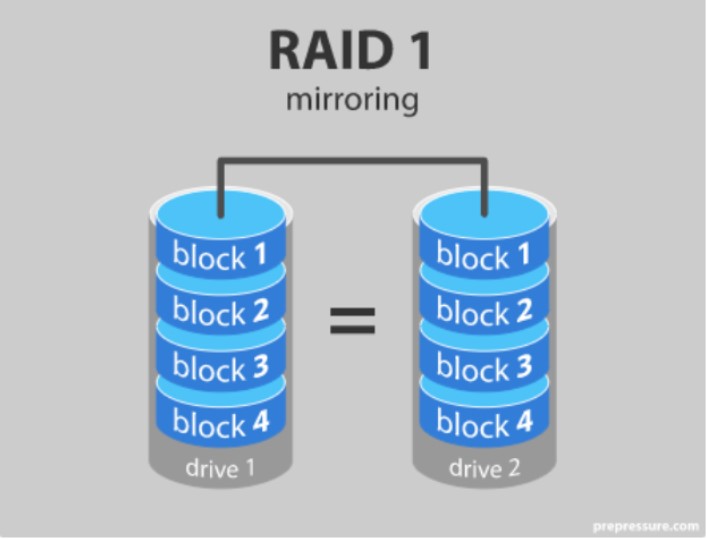
Fonte: Dicas de Infra
RAID 2
RAID 2 is one of the RAID levels that has fallen into disuse, since its operation has been incorporated into today’s disks. It is similar to RAID 0 in that the content is divided between the disks, but it adds error control and correction algorithms, which provide additional protection in the event of failures.
Advantages
- Offers a layer of data protection;
Increases processing speed.
Disadvantages
- It’s an obsolete technique compared to today’s disks;
No mirroring or data paritys.
RAID 3
From RAID 3, all mechanisms use parity resources. In RAID 3, data is divided into small blocks, which receive additional bits – the parity bits – on a new disk, which is responsible for identifying and correcting errors on the drives.
Advantages
- Increases data read and write speeds;
Provides protection against disk failures.
Disadvantages
- Difficult to set up in the application via software.
RAID 4
RAID 4 is another level that uses parity resources. It’s similar to RAID 3, but the data is split between the disks and can be reconstructed using the parity bits on an additional disk.
You can have three disks, for example, which effectively store the data, while a fourth disk stores the parity. In other words, you only need one additional disk for data protection, while RAID 1 requires several mirrored disks.
Advantages
- Garante a segurança dos dados por paridade;
- Reduz o custo da proteção dos dados.
Disadvantages
- If a disk fails, reconstructing the data is more difficult than with RAID 1, which already has the data mirrored;
It uses an old technique that has been superseded.
RAID 5
RAID 5 represents an evolution of the previous levels. It can also be called striping with parity.
In this case, the parity resources are not stored on an additional exclusive disk as in RAID 4. They are distributed alternately across several disks. If a disk fails, a process called “rebuild” can be triggered to reconstruct the data.
However, if one disk fails, rebuilding tends to take a long time. And if another drive fails during the rebuild, data can be lost
Advantages
- It offers a more robust data protection system;
- Faster to read data and identify disk errors;
- Guarantees drive availability even if a disk fails or is under reconstruction.
Disadvantages
- It is a little slower to write data due to parity calculations;
It has a complex technique that delays data restoration time.
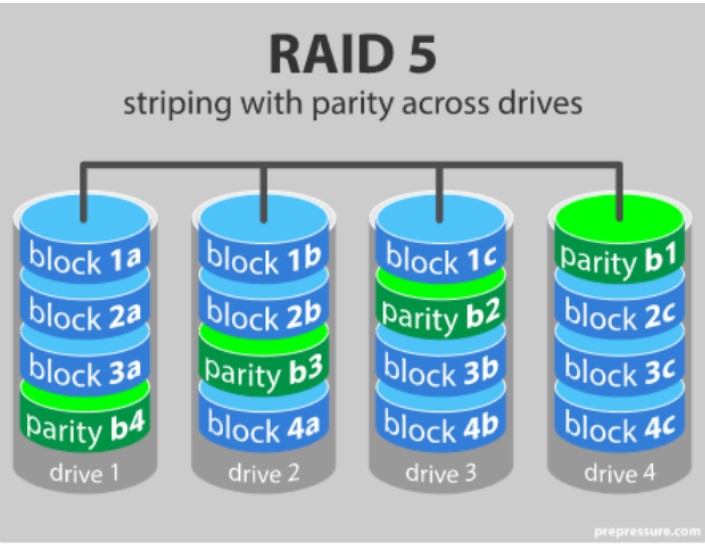
Fonte: Dicas de Infra
RAID 6
RAID 6, also called double parity striping, works like RAID 5, but offers greater data security in the event of two drives failing simultaneously.
This is because RAID 6 writes the parity data to two different drives. This way, if one disk fails, the RAID array survives if a second one fails. So it has access to the data even if the drives are being restored.
Advantages
- It is quick to read data and identify disk errors;
Guarantees data availability even in the event of a double failure.
Disadvantages
- Writes data more slowly than RAID 5 due to additional parity calculations;
It has a complex technology that affects reconstruction speed.
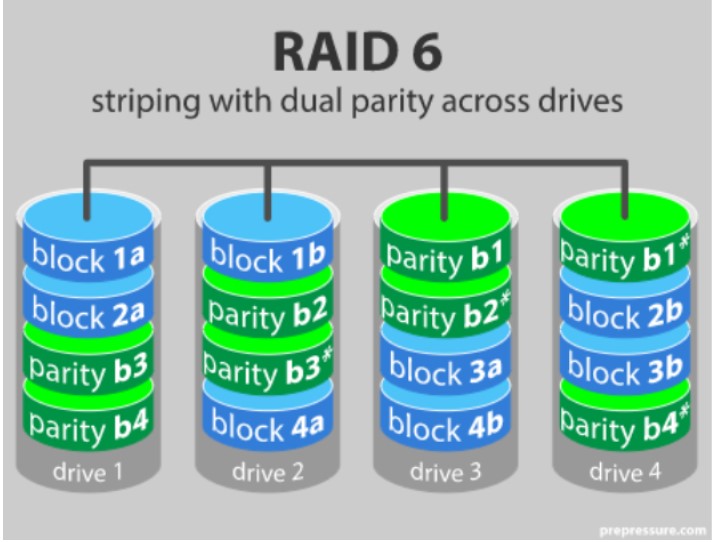
Fonte: Dicas de Infra
RAID 10
RAID 10 can be considered a combination of RAID 1 and RAID 0, with its advantages and disadvantages. This system has data mirrored on secondary drives (characteristic of RAID 1), which guarantees greater security, but also uses data distribution (characteristic of RAID 0) to speed up processing.
This means that when a disk fails, the time it takes to recover the data from the drive is much faster, as it is mirrored. On the other hand, the cost of storage becomes higher, since half of the capacity goes to mirroring.
Advantages
- Guarantees data security with mirroring;
Increases data transfer and recovery speed.
Disadvantages
- It is an expensive solution for redundancy;
It has a high memory expansion cost (requires a minimum of 4 disks).
How is RAID implemented?
Now that you have a better understanding of what RAID is and what types and levels exist, let’s take a practical look at how to implement a disk array.
RAID can be implemented in two ways: via software and via hardware. To decide which option is best, it’s important to assess the company’s infrastructure, your objectives when installing RAID (focus on security or performance) and the availability of resources, since each solution has a cost.
Regardless of which option you choose, it is important to rely on qualified professionals or companies to carry out this type of procedure. A wrong implementation action can affect the functioning of the disks and make their use unfeasible. So be careful.
Here’s how the procedures work:
Via software
In software implementation, the operating system manages RAID via the disk manager. This form of implementation tends to be more flexible and cheaper, but it can compromise the machine’s performance by occupying the processor with calculations of where the data should be stored.
To do this, you need to have two or more disks with the same speed and capacity. Once you have installed the volumes on your computer, you need to configure RAID in Windows.
Then go to the Windows Disk Manager in Administrative Tools. There, find the disk that doesn’t have an allocated volume, right-click on it and choose the “Create distributed volume” option.
Next, select the unallocated volumes that should be part of your RAID system and set their size. Finalize the settings, set a letter for the drive and finish the process by quickly formatting the drive. After that, you have a working RAID.
Via hardware
Implementation via hardware tends to be more efficient, but also more complex. To do this, you need at least two hard disks and a controller, which allow you to set up a RAID 0 or a RAID 1.
First, you need to install the hardware components. Connect the disks to the ports managed by the RAID controller. Then configure the RAID so that the disks work together. To do this, you need to access the motherboard settings and change the ports being used from “IDE” to “RAID”.
After that, enter the POST (Power-On Self Test) configuration mode, which shows that the RAID system is not yet running and allows you to configure it. In this mode, you can create the RAID volume, set the level (RAID 0 or RAID 1) and the size of the partition.
Finally, just configure the operating system to make the RAID functional. The system probably won’t recognize the RAID volume and will ask you for a drive to install it. So use a USB stick or memory card with the drive. After installation, the operating system should recognize the two volumes as a single drive.
Now you know what a RAID is, what its functions are and how to use it. These solutions are generally used in companies and organizations that work with large volumes of data and need to guarantee data security and the performance of their machines.
But RAID can be implemented by any user, as long as they have the technical knowledge to do so – or, of course, have professional help.
RAID data recovery
Bot has offices from the north to the south of Portugal. As well as offering RAID data recovery services, we also work with data recovery from disks, SSDs, memory cards, USB sticks and devices affected by ransomware.
In addition, Bot offers free analysis and collection of devices from any address in Portugal. So if you need to recover any RAID configuration, trust the professionals at Bot, who have successfully solved more than 100.000 cases.


